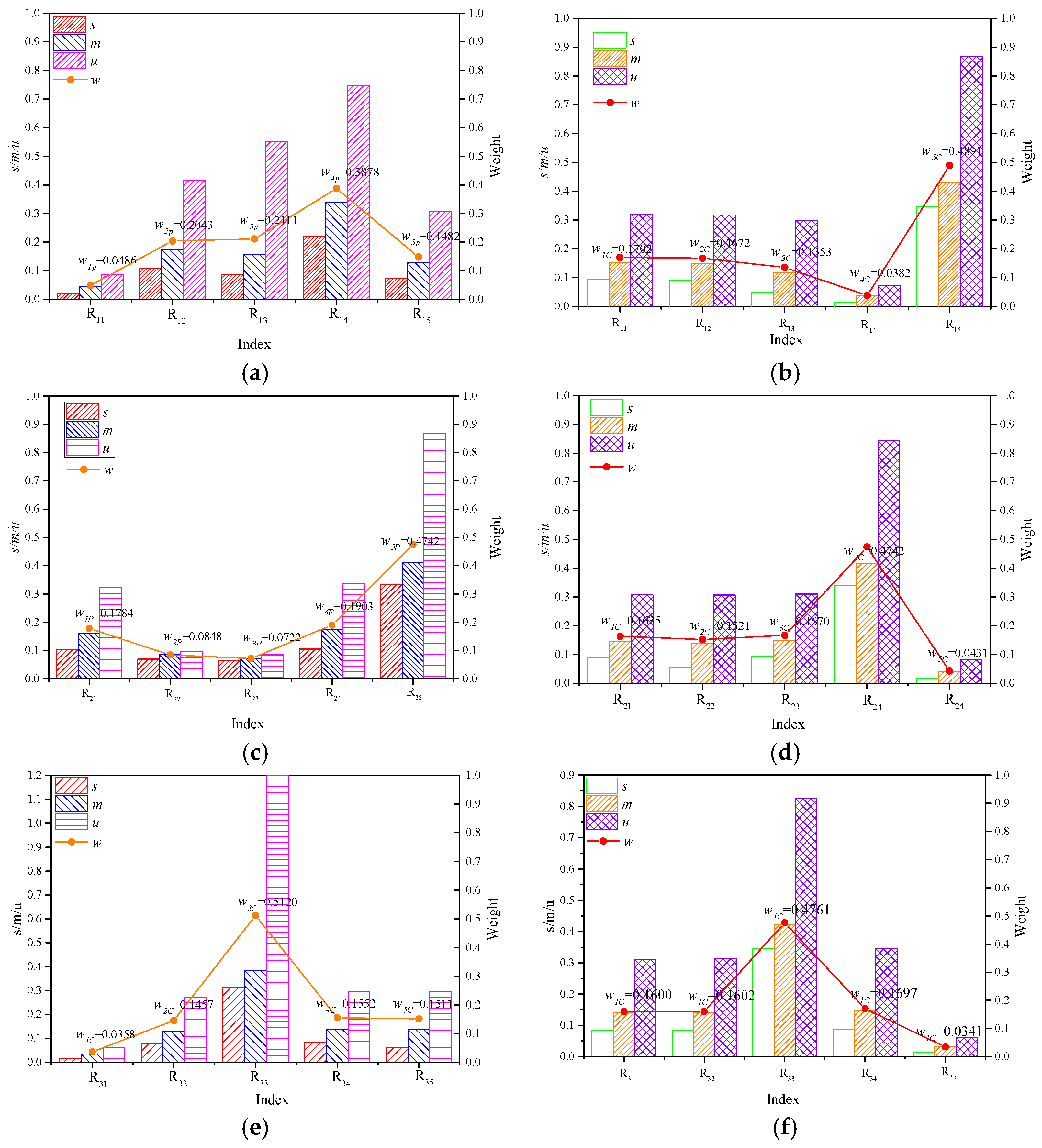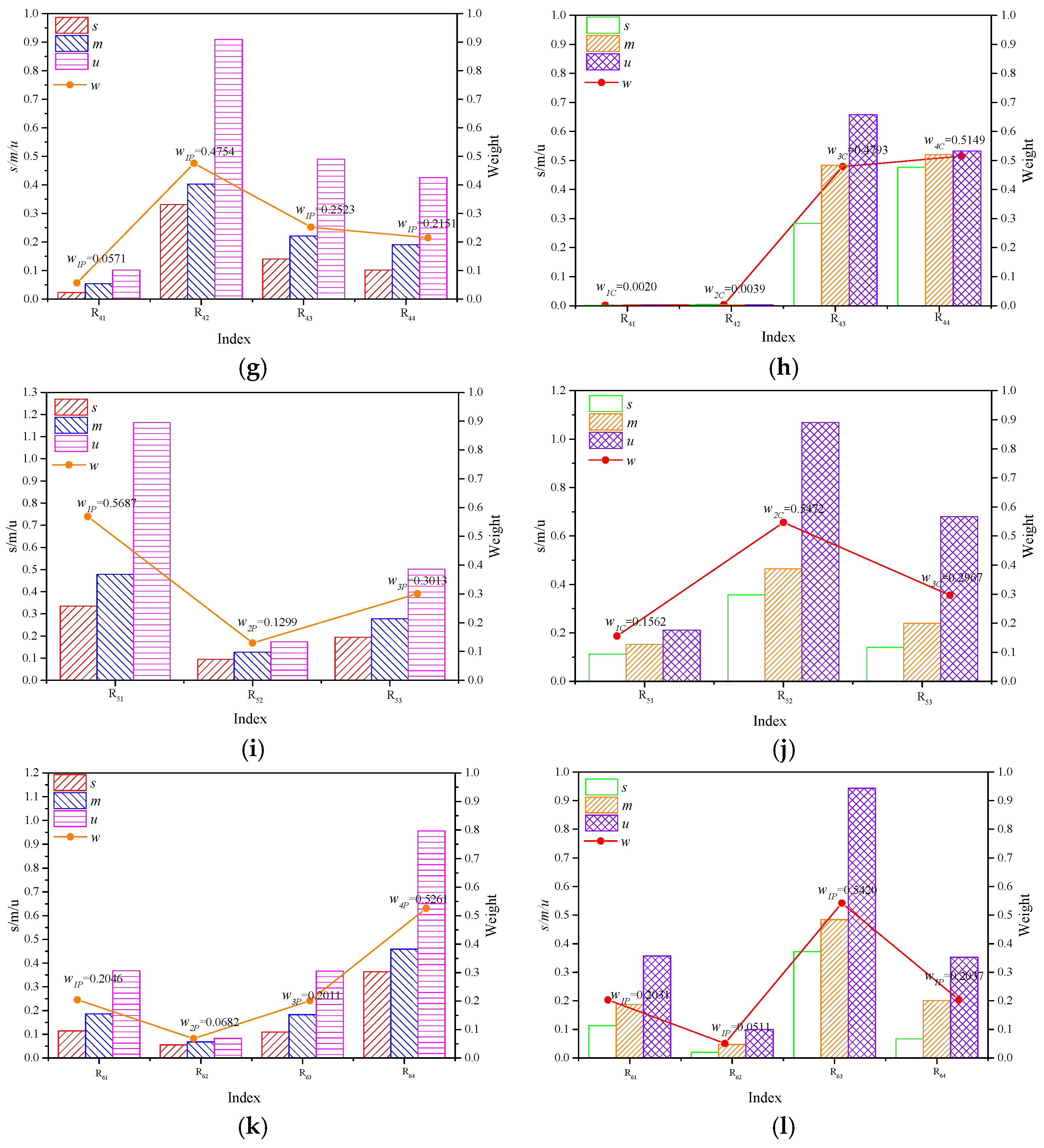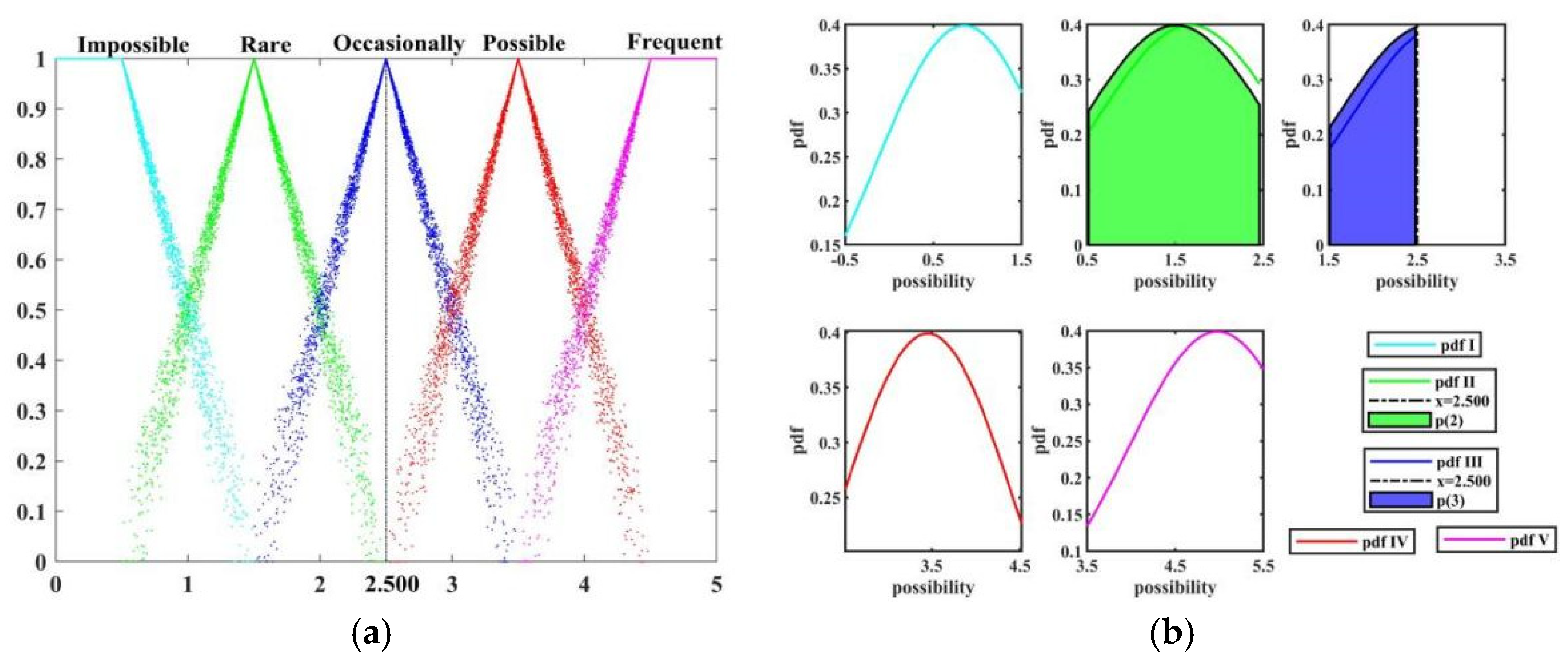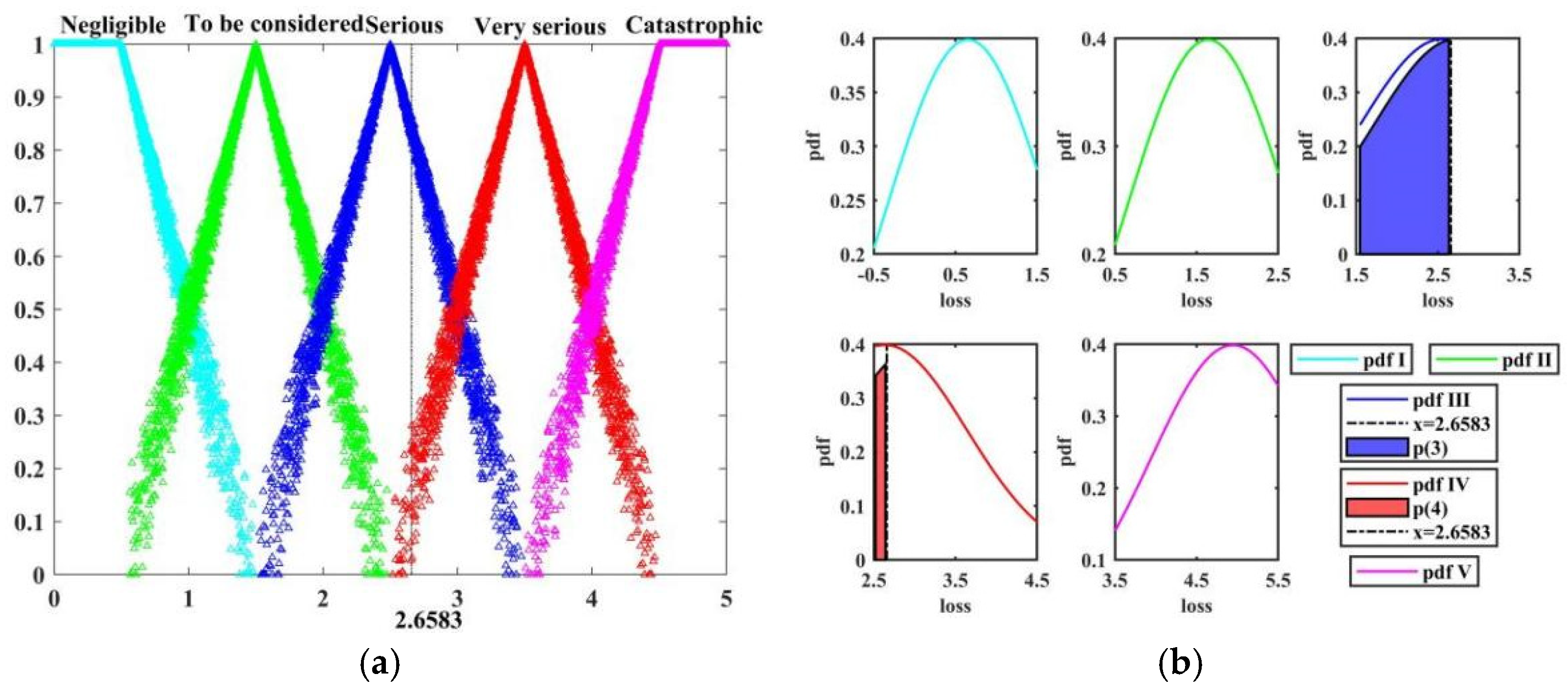Multifactor Uncertainty Analysis of Construction Risk for Deep Foundation Pits
Abstract
:1. Introduction
2. Method
3. Risk Evaluation System for Deep Foundation Pit Construction
3.1. Evaluation Index
3.2. Risk Evaluation Criteria and Grade Quantification
3.2.1. Risk Evaluation Criteria
3.2.2. Quantification of Risk Grade
3.3. Weight Determination Method of the Index
3.3.1. Fuzzy Sets and Triangular Fuzzy Numbers
3.3.2. Determination of Index Weight on the Basis of FBWM
3.3.3. Consistency Test
3.4. Improved Fuzzy Comprehensive Evaluation Method
3.4.1. Triangle Cloud Model
3.4.2. Fuzzy Comprehensive Evaluation
4. Project Case Analysis
4.1. Project Overview
4.2. Index Weight Results and Analysis
4.3. Comprehensive Evaluation and Probability Analysis
5. Comparison with Combination Weight—Traditional Fuzzy Comprehensive Evaluation Method
6. Conclusions
Author Contributions
Funding
Institutional Review Board Statement
Informed Consent Statement
Data Availability Statement
Conflicts of Interest
References
- Nie, S.M.; Ren, F. Study on risk management of deep foundation pit engineering. Appl. Mech. Mater. 2014, 638–640, 574–579. [Google Scholar] [CrossRef]
- Zhou, H.B.; Zhang, H. Risk assessment methodology for a deep foundation pit construction project in Shanghai, China. J. Constr. Eng. Manag. 2012, 137, 1185–1194. [Google Scholar] [CrossRef]
- Eskesen, S.D.; Tengborg, P.; Kampmann, J.; Veicherts, T.H. Guidelines for tunnelling risk management: International tunnelling association, working group No. 2. Tunn. Undergr. Space Technol. 2004, 19, 217–237. [Google Scholar] [CrossRef]
- Du, X.L.; Zhang, X.F.; Zhang, M.J.; Zhang, M.J.; Hou, B.W. Risk synthetic assessment for deep pit construction based on evidence theory. Chin. J. Geotech. Eng. 2014, 36, 155–161. (In Chinese) [Google Scholar]
- Wang, Q.K.; Kang, X.W.; Zhu, K. Coupling evaluation method of the construction risk for subway deep foundation pit. J. Northeast. Univ. (Nat. Sci.) 2021, 42, 1152–1158. (In Chinese) [Google Scholar]
- Hu, C.M.; Liu, L.; Wang, X.H.; Jia, W.B.; Lin, C.; Ma, Z. Risk assessment for the 2D deep foundation pit based on the fuzzy entropy-cloud theory. J. Saf. Environ. 2021, 21, 521–528. (In Chinese) [Google Scholar]
- Cao, W.G.; Zhai, Y.C.; Zhang, Y.J. Improved risk matrix method of instability risk for excavations with cantilever retaining. Chin. J. Geotech. Eng. 2012, 34, 210–216. (In Chinese) [Google Scholar]
- Valipour, A.; Yahay, N.; Noor, N.M.; Antucheviciene, J.; Tamosaitiene, J. Hybrid SWARA-COPRAS method for risk assessment in deep foundation excavation project: An iranian case study. J. Civ. Eng. Manag. 2017, 23, 524–532. [Google Scholar] [CrossRef]
- You, W.B.; Wang, J.B.; Zhang, W.; Liu, F.M.; Yang, D.Y. Construction risk assessment of deep foundation pit in metro station based on G-COWA method. IOP Conf. Ser. Earth Environ. Sci. 2018, 153, 052018. [Google Scholar] [CrossRef]
- Zhang, L.; Li, H.B. Construction risk assessment of deep foundation pit projects based on the projection pursuit method and improved set pair analysis. Appl. Sci. 2022, 12, 1922. [Google Scholar] [CrossRef]
- Huang, Z.; Zhang, W.; Zhang, J.B.; Fu, H.L.; Yang, W. Statistics and probability characteristics of typical surface defects of subway tunnels. J. Perform. Constr. Facilities. 2021, 36, 04021118. [Google Scholar] [CrossRef]
- Guo, S.; Zhao, H.R. Fuzzy best-worst multi-criteria decision-making method and its applications. Knowl. Based Syst. 2017, 121, 23–31. [Google Scholar] [CrossRef]
- Di, K.C. Spatial Data Mining and Knowledge Discovery; Wuhan University Publishing: Wuhan, China, 2001. (In Chinese) [Google Scholar]
- Huang, Z.; Fu, H.L.; Zhang, J.B.; Chen, W.; Shi, Y. Structural damage evaluation method for metro shield tunnel. J. Perform. Constr. Facil. 2019, 33, 04018097. [Google Scholar] [CrossRef]
- Nie, S.M.; Liu, J.Y. The risk management practice of a deep foundation pit project. Appl. Mech. Mater. 2014, 638–640, 703–709. [Google Scholar] [CrossRef]
- GB 50652-2011; Code for Risk Management of Underground Works in Urban Rail Transit. PRC Ministry of Housing and Urban-Rural Development: Beijing, China, 2011. (In Chinese)
- Zhang, W.; Sun, K.; Lei, C.Z.; Zhang, Y.C.; Li, H.X.; Spencer, B.F. Fuzzy Analytic Hierarchy Process Synthetic Evaluation Models for the Health Monitoring of Shield Tunnels. Comput.-Aided Civil Infrastruct. Eng. 2014, 29, 676–688. [Google Scholar] [CrossRef]
- Rezaei, J. Best-worst multi-criteria decision-making method. Omega Int. J. Manag. Sci. 2015, 53, 49–57. [Google Scholar] [CrossRef]
- Zadeh, L.A. Fuzzy sets. Inf. Control 1965, 8, 338–353. [Google Scholar] [CrossRef]
- Lyu, J.; Cheng, X.F.; Shaw, P. Terrain hazard risk analysis for flood disaster management in Chaohu basin, China, based on two-dimensional cloud. J. Adv. Comput. Intell. 2020, 24, 532–542. [Google Scholar] [CrossRef]








| Grade (P) Grade (C) | 1 | 2 | 3 | 4 | 5 | |
|---|---|---|---|---|---|---|
| Negligible | Need Consider | Serious | Very Serious | Catastrophic | ||
| 1 | Impossible | Grade I | Grade I | Grade I | Grade II | Grade II |
| 2 | Rare | Grade I | Grade I | Grade II | Grade II | Grade III |
| 3 | Occasionally | Grade I | Grade II | Grade II | Grade III | Grade IV |
| 4 | Possible | Grade II | Grade II | Grade III | Grade IV | Grade IV |
| 5 | Frequent | Grade II | Grade III | Grade IV | Grade IV | Grade IV |
| Grade | 1 | 2 | 3 | 4 | 5 |
|---|---|---|---|---|---|
| Description | Impossible | Rare | Occasionally | Possible | Frequent |
| Score interval | (0.8, 1] | (0.6, 0.8] | (0.4, 0.6] | (0.2, 0.4] | (0, 0.2] |
| Grade | 1 | 2 | 3 | 4 | 5 |
|---|---|---|---|---|---|
| Description | Negligible | Needs consideration | Serious | Very serious | Catastrophic |
| Score interval | (0.8, 1] | (0.6, 0.8] | (0.4, 0.6] | (0.2, 0.4] | (0, 0.2] |
| Fuzzy Linguistic Variables | Membership Function (Triangular Fuzzy Number) | Consistency Index C.I. |
|---|---|---|
| Equally important | (1, 1, 1) | 3 |
| More important | (2/3, 1, 3/2) | 3.802 |
| Important | (3/2, 2, 5/2) | 5.291 |
| Very important | (5/2, 3, 7/2) | 6.692 |
| Particularly important | (7/2, 4, 9/2) | 8.041 |
| Grade | 1 | 2 | 3 | 4 | 5 |
|---|---|---|---|---|---|
| P | Impossible | Rare | Occasionally | Possible | Frequent |
| C | Negligible | Need consider | Serious | Very serious | Catastrophic |
| Grade quantification | (−0.5, 1.5] | [0.5, 2.5] | [1.5, 3.5] | [2.5, 4.5] | [3.5, 5.5) |
Publisher’s Note: MDPI stays neutral with regard to jurisdictional claims in published maps and institutional affiliations. |
© 2022 by the authors. Licensee MDPI, Basel, Switzerland. This article is an open access article distributed under the terms and conditions of the Creative Commons Attribution (CC BY) license (https://creativecommons.org/licenses/by/4.0/).
Share and Cite
Zhang, W.; Huang, Z.; Zhang, J.; Zhang, R.; Ma, S. Multifactor Uncertainty Analysis of Construction Risk for Deep Foundation Pits. Appl. Sci. 2022, 12, 8122. https://doi.org/10.3390/app12168122
Zhang W, Huang Z, Zhang J, Zhang R, Ma S. Multifactor Uncertainty Analysis of Construction Risk for Deep Foundation Pits. Applied Sciences. 2022; 12(16):8122. https://doi.org/10.3390/app12168122
Chicago/Turabian StyleZhang, Wei, Zhen Huang, Jiabing Zhang, Ruifu Zhang, and Shaokun Ma. 2022. "Multifactor Uncertainty Analysis of Construction Risk for Deep Foundation Pits" Applied Sciences 12, no. 16: 8122. https://doi.org/10.3390/app12168122
APA StyleZhang, W., Huang, Z., Zhang, J., Zhang, R., & Ma, S. (2022). Multifactor Uncertainty Analysis of Construction Risk for Deep Foundation Pits. Applied Sciences, 12(16), 8122. https://doi.org/10.3390/app12168122






